Go Zero Waste!
Want to hold a zero waste event? Check out this short guide for zero waste events with tips and tricks gathered from our years of experience working with events of all sizes.
Interested in learning more about what Zero Waste is? Hop over to our About Page and learn the basics of Zero Waste.
How to Zero Waste your Event
Zero Waste is an approach to resource management that conserves, repurposes and recycles what otherwise would be buried in a landfill. This material is then turned into valuable assets that contribute to environmental, economic and social well-being. A true zero waste event diverts 90% of all materials generated and discarded during an event from the landfill through reuse, composting or recycling.
But how to get there?
This guide is a great place to start when thinking about going zero waste. For small events this might be enough to make a huge impact on your event’s waste.
For large events, these tips are a great place to start, but if you’re looking for a way to turn your zero waste dream into a realty check out our services page to learn more about what Zero Waste Event Productions can do for you.
Step 1) Plan Ahead
Think about all aspects of your event or festival, so you can determine what might need done to go zero waste.
Ask yourself:
- What materials will be generated?
- Will food be served?
- Will materials be clean or dirty?
- Who will help make this even zero waste?
- What will we use to decorate?
- How many people will be in attendance?
- Who can haul the materials?
- Will there be games or activities?
- How will I advertise?
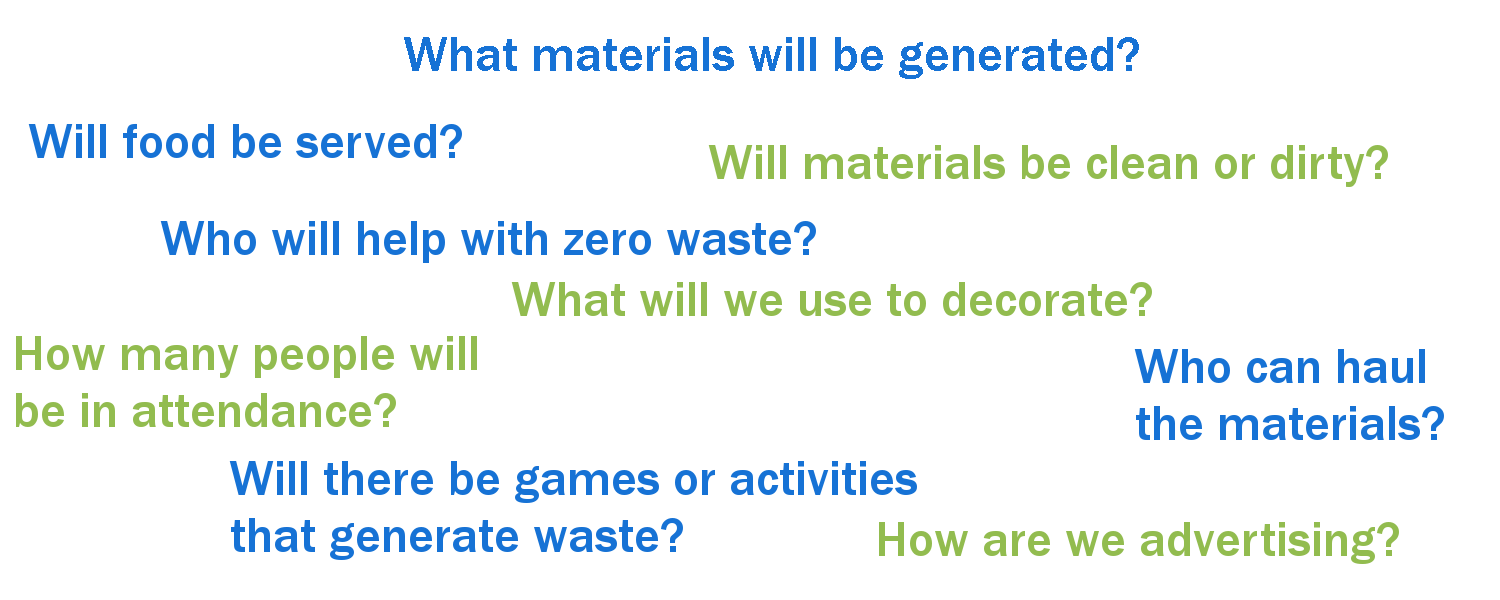
Step 2) Identify Possible Waste
Identify all of the possible waste materials that might be generated at your event.
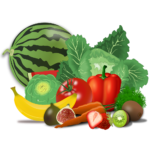
Compost is anything that will biodegrade back into soil. This could happen in a backyard compost bin or in an industrial compost system.
Compost includes:
- Fruit and vegetable scraps- peels, cores moldy or dirty scraps, full fruits and vegetables
- Leaf litter, grass clippings or other small yard debris
- Dairy products
- Plain colored napkins and other paper products
- Non-glossy white paper plates
- Meat scraps*
- Certified compostable serviceware, including PLA plastic*
*Not every material will break down well in every system. Learn more about what your compost bin or your local compost facility can accept before sending them all of the above materials.

Recyclables are anything that could be processed and turned into a new products. Ideally everything could be recycled, but often we’re limited to what can be recycled at a local recycling facility.
Examples of easily recyclable products are:
- Paper
- Plastic bottles
- Aluminum cans
- Tin cans
- Glass bottles
Examples of more difficult products to recycle are:
- Scrap metal
- All plastics including plastic cups, containers, plates and silverware
- Batteries
- Electronics
- Film plastic (shopping bags, bubble wrap, etc.)
- Clothing and textiles (often can be taken to second-hand stores)
Not all materials are recycled in every location. Look into what your local facility accepts before sending them materials.

True Trash is any material that cannot be reused, recycled, composted or otherwise rescued from the landfill. In practice, this category is usually reserved for items that are too dirty to be recycled or are very hard to recycle, reuse, or compost.
These products are often but not necessarily:
- Chip bags, granola bar wrappers, cereal bags, or other snack packaging
- Extruded polystyrene foam (styrofoam) food containers
- Any recyclable material contaminated with food/dirt/paint/glue
- Paint, glue or other craft supplies
- Hazardous waste (should be properly disposed of)
- Cigarette butts
Many of these can be recycled or reused if the proper systems are in place. Look into local hard to recycle material facilities or check out the outside resources tab at the bottom of this page for resources for hard-to-recycle materials.
Step 3) Reduce, then Reuse, then Recycle/Compost
Look at your waste materials and ask:
Can I reduce it?
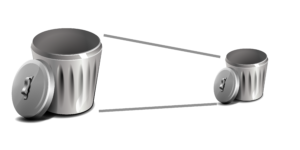
Reduce Food Waste
According to the USDA 40% of food grown in the US is never eaten.
Here are some tips for minimizing food waste at your next event:
- Get an accurate headcount of attendees, and plan food for that many people.
- Serve plated meals as the preparer doesn’t serve more food than a person can eat.
- In a buffet or potluck style meal-
- Remind attendees to take small portions and come back for seconds.
- Offer containers, or ask attendees to bring containers to take home leftover food.
- Contact a local food rescue or homeless shelter to see if they take leftover food.
- Packaged hot dog buns, hamburger buns, condiments, salads and unopened food can be given to those in need.
- Learn more about The Good Samaritan Food Donation Act that covers goodwill food donations.
- Learn more about reducing food waste with these resources from the EPA.
Reduce Single-Use Bottles
About 60 million water bottles are sent to the landfill every day.
You can decrease plastic waste at your event with these tips:
- Ask attendees to bring their own water bottles or cups to avoid the need for single use bottles or styrofoam coffee cups.
- Offer reusable cups or mugs.
- Offer drinks in bulk
- At large events, provide a water refill station
- Have vendors provide discounts for individuals who bring a reusable coffee cup*
- At smaller events a water cooler, coffee pot or pitcher will keep people’s bottles and cups full.
*Be sure to check local and state health codes in relation to reusable serviceware. Most states have no laws restricting drinking vessels from being reused at stores.
Reduce Promotional Waste
Paper can only be recycled an average of 5-7 times before being trashed.
Reduce paper waste completely with these tips:
Promotional Waste:
- Use e-mail, t.v. radio, and the internet to advertise your event.
- For paper advertisments
- Post one very visible flyer instead of handing out several smaller fliers.
- Encourage people to take a picture of a paper ad on their phone instead of taking a paper copy that may only be looked at once before being discarded.
- Decrease invitation waste, by sending postcards instead of envelopes with an invitation inside.
- Print fliers you plan to hang up on paper that has already been printed on one side.
- Design event signs (sponsor signs, direction signs, informational signs) that can be stored and used year-after-year.
- Cloth or vinyl signs with removable dates, times and other information can look good and be used year after year.
Conference Waste:
- Project presentations onto a screen instead of printing out documents
- Only hand out unnecessary papers if someone asks for them
- Notify attendees of Zero waste goals, so they can work with the organizers to create a zero waste event.
- Serve sugar and creamer in bulk to minimize single use sugar and creamer packet waste.
- Have people take pictures of maps, and schedules to cut down on paper waste
- Reuse nametags
Can I reuse it?

Reuse Dishware
It’s estimated that about 20,000 tons of EPS (styrofoam) products end up in the waste stream from a single metropolitan area in one year.
Reduce single-use dish ware at your event by:
- Asking attendees to bring their own dishes
- Borrowing or renting reusable dish ware
- Worried about clean-up? Have the community help with cleanup
- learn more about 3-bin cleaning systems here
- Hand out cloth napkins that can be washed and reused.
Reuse Cups
Americans throw away 25 billion styrofoam cups every year, this doesn’t include countless solo or plastic cups.
Reduce single-use cups by:
- Asking attendees to bring their own cups or coffee mugs.
- If attendees need to purchase a drink, encourage reusable cups by offering a bring-your-own cup discount.
- At small gatherings offer reusable coffee mugs.
- At large events with drinks, sell reusable cup that can be kept as a souvenir after the event is over.
Reuse Decorations
- Make signs that can be stored and used year after year.
- Decorate naturally
- Use flowers, rocks, and natural wreathes to decorate.
- Use cloth table clothes
- Get creative and make decorations and make use of second-hand or reused items.
Can I recycle/compost it?
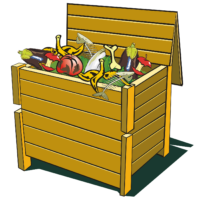
Can I compost it?
Compost Serviceware
Compostable serviceware is a unique alternative to extruded polystyrene foam (styrofoam) or other petroleum-based products. Compostable products can be sent to certain compost facilities instead of being sent to the landfill. These products are often made of corn or potato meaning they’re made from renewable resources, and can be safely returned to the earth.
Unlike recyclable serviceware compostable serviceware doesn’t have to be cleaned of all food scraps before being composted as food is similarly biodegradeable.
How to properly dispose of compostable serviceware:
Check with your local compost facility to make sure they accept compostable serviceware. Plastic compostables or PLA plastic often needs special treatment in a compost facility before it will break down properly.
Paper plates, bowls and cups can break down in many conditions including in backyard compost bins, as long as there is a reasonable mixture of green (food) and brown (paper/leaves) ratio. Learn more about backyard composting here: Composting Basics for Beginners
You can find more information about compostable products here: Biodegradable Products Institute
Want to buy compostable serviceware for your next event?
- In Ohio? Support a local retailer and purchase all your compostable serviceware from Going Green Services (A long time partner of Zero Waste Event Productions): Going Green Services
- NatureWorks makes Ingeo products.
- Eco Products has a wide selection of compostable serviceware.
- Find more Compostable products on the Biodegradable Products Institute’s Website
Not enough money for certified compostable products?
Cheap white paper plates with no color or glossy covering will break down in backyard compost bins as will plain paper napkins. It’s a great first step toward going zero waste!
Compostable Decorations
Natural or compostable decorations are a great alternative to single-use decorations such as balloons, vinyl tablecloths, and plastic decorations.
Natural decorations including flowers, wreathes, and rocks, can all be composted or put back into nature at the end of an event.
- Put some zero waste Pintrest flair on your next event and aim to be able compost all your decoration: Zero Waste Party Ideas
- Some more nature based alternatives to balloons can be found here: Balloonsblow
Some papers and other fiber-based decorations are compostable or biodegradable, including certain types of confetti. Keep this in mind when planning your next event.
Compost Leftover food
Lack of oxygen (anaerobic) conditions in a landfill can cause decomposing food to turn into methane, a greenhouse gas 23x as potent as CO2. Avoid contributing food to the landfill by composting as much food waste from your event as possible.
In a compost bin or compost facility food breaks down more effectively and creates a byproduct that is helpful to communities (fertilizer).
Composting food scraps at your event is simple.
First learn what you can compost:
- Do you have your own compost bin? What can and can’t you take.
- Hauling compost to a local facility? What do they take? Sometime concerns about rodents, smells, or bugs means facilities will not take certain food scraps including oils, meat, and dairy.
Next, set out bins to collect waste:
- For small events
- A five gallon bucket or one gallon ice-cream container next to a dishwashing station or trash bin is suffient for collecting food scraps.
- Have good signage with words and pictures explaining what goes where, or station a volunteer next to the bin to help people scrape their plates.
- For large events
- Scale bins by size of event. Be careful if you’re collecting in bags, as food waste is heavy and a full 33 gallon bag could weigh up to 50 lbs.
- Have good signage with words and pictures explaining what goes where.
- Have volunteers sort through bags to check for contamination. Most compost facilities only accept a small percentage of contamination (<.5%), and this is the most effective way to make sure your material is clean.
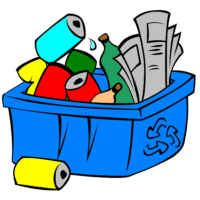
Can I recycle it?
Recycle serviceware
Bottles and Cans –
Bottles and cans are easily recyclable and can be collected in recycling bins at your event.
Cups
Extruded polystyrene foam (Styrofoam), paper coffee cups, and plastic cups like solo cups are only recyclable in certain areas. Check with your hauler or recycling center to see what they take when you’re deciding what products to have at your event.
Consider compostable or reusable cups.
Bowls and Plates
Plastic bowls and plates are only recyclable in certain areas, and only if they are clean. Check with your hauler or recycling center to see what they take when you’re deciding what products to have at your event.
Consider compostable or reusable plates, and bowls.
Plastic silverware–
Plastic knives, spoons, and forks are only recyclable in certain areas, and only if they are clean. Check with your local recycling facility to see if they accept plastic silverware.
Consider compostable or reusable silverware.
A note on contamination
Food is the number 1 contaminant at recycling centers.
Contamination in a load of recycling can make it impossible for a recycling center to sell their product meaning an entire load of recycling could be taken to the landfill instead of properly recycled. You may save an entire load of recycling by simply throwing out a dirty plate before it reached their system.
Paper, extruded polystyrene foam (styrofoam) and plastic cups, plates and bowls are often too contaminated to be recycled. If your recycling center accepts plastic or paper plates, be sure to clean them of all food contaminants before recycling.
Compost and Recycling Tips and Tricks
Outside Resources
- Learn more about holding your own zero waste event with Rural Action’s Zero Waste Event guide: Rural Action’s Zero Waste Guide.
- Learn about the importance of proper waste management with the EPA: Reduce, Reuse, Recycle
- Learn more about Zero Waste in your area, and get involved: Eco Cycle Solutions
- A guide to zero waste from Spruce Up
- Learn more about sustainable food waste management with the EPA’s web guide: Sustainable Management of Food.
- Curious about compostable serviceware, learn more here: Biodegradable Products Institute
- Want to buy compostable serviceware for your next event?
- In Ohio? Support a local retailer and purchase all your compostable serviceware from Going Green Services (A long time partner of Zero Waste Event Productions): Going Green Services
- NatureWorks makes Ingeo products.
- Eco Products has a wide selection of compostable serviceware.
- Find more Compostable products on the Biodegradable Products Institute’s Website
- Before you compost all food scraps have you considered these other food waste disposal tactics?: Hierarchy of food waste
- Worried about donating food? Learn more about the Good Samaritan Law that protects goodwill food donations: Feeding America
- Curious about starting your own compost system? Learn how with these great resources:
=
- If your event has hard to recycle materials, TerraCycle might have your solution: TerraCycle
- Learn more about recycling in the United States: EPA, Reduce, Reuse, Recycle
Avoiding work? So are we. Enjoy these fun recycling-based games to pass the time.
- Test your zero waste knowledge with this fun game: Kid Science Challenge
- Sort recycling and compost at a park with this National Geographic game.
- Ever wanted to work at a Material Recovery Facility (really big recycling center)? Now you can in this fun game from I Want to Be Recycled, a partner of Keep America Beautiful.
- NASA ClimateKids has 4 great educational panels, on greenhouse gasses, coral bleaching, and other off-the-beaten-path topics.
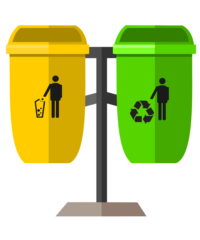
Pair Your Bins
Some people don’t think about recycling or composting, and if they see a bin they’ll use it for whatever is in their hand.
Make sure your recycling and compost bins are protected by pairing them with a trash bin. This will decrease contamination in your recycling and help show that you’re making an effort to recycle.
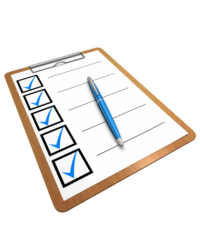
Double Check
Most recycling and compost facilities can only accept a certain amount of contamination in a load before they throw everything out. When in doubt double check all your recycling and compost bags for contaminants. Doing so will ensure the materials you collected will be recycled or composted.
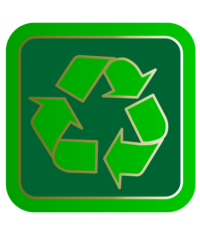
Post Clear Signage
Recycling and compost rules change from place to place.
To get the cleanest recycling stream have clear signage on all of your bins. A mixture of pictures and words helps attendees from all backgrounds and ages properly use your bins.
To further decrease contamination consider restrictive lids on recycling bins (like circles or slits). This helps people match their waste with the proper bin.
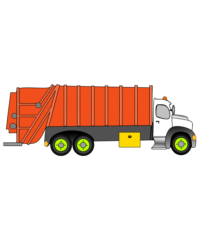
Know Your Hauler
Before collecting recycling or compost at your event, know what materials your local recycling or compost facility takes.
Does your recycling center only take 1 and 2 plastics?
Does your compost facility accept materials that are stamped “compostable in an industrial facility?”
Research this before sending the wrong materials. Too much contamination in your recycling or compost could mean they throw everything in a load out.
Compost and Recycling Tips and Tricks

Post Clear Signage
Recycling and compost rules change from place to place.
To get the cleanest recycling stream have clear signage on all of your bins. A mixture of pictures and words helps attendees from all backgrounds and ages properly use your bins.
To further decrease contamination consider restrictive lids on recycling bins (like circles or slits). This helps people match their waste with the proper bin.

Know Your Hauler
Before collecting recycling or compost at your event, know what materials your local recycling or compost facility takes.
Does your recycling center only take 1 and 2 plastics?
Does your compost facility accept materials that are stamped “compostable in an industrial facility?”
Research this before sending the wrong materials. Too much contamination in your recycling or compost could mean they throw everything in a load out.

Pair Your Bins
Some people don’t think about recycling or composting, and if they see a bin they’ll use it for whatever is in their hand.
Make sure your recycling and compost bins are protected by pairing them with a trash bin. This will decrease contamination in your recycling and help show that you’re making an effort to recycle.

Double Check
Most recycling and compost facilities can only accept a certain amount of contamination in a load before they throw everything out. When in doubt double check all your recycling and compost bags for contaminants. Doing so will ensure the materials you collected will be recycled or composted.
Outside Resources
- Learn more about holding your own zero waste event with Rural Action’s Zero Waste Event guide: Rural Action’s Zero Waste Guide.
- Learn about the importance of proper waste management with the EPA: Reduce, Reuse, Recycle
- Learn more about Zero Waste in your area, and get involved: Eco Cycle Solutions
- Learn more about sustainable food waste management with the EPA’s web guide: Sustainable Management of Food.
- Curious about compostable serviceware, learn more here: Biodegradable Products Institute
- Want to buy compostable serviceware for your next event?
- In Ohio? Support a local retailer and purchase all your compostable serviceware from Going Green Services (A long time partner of Zero Waste Event Productions): Going Green Services
- NatureWorks makes Ingeo products.
- Eco Products has a wide selection of compostable serviceware.
- Find more Compostable products on the Biodegradable Products Institute’s Website
- Before you compost all food scraps have you considered these other food waste disposal tactics?: Hierarchy of food waste
- Worried about donating food? Learn more about the Good Samaritan Law that protects goodwill food donations: Feeding America
- Curious about starting your own compost system? Learn how with these great resources:
=
- If your event has hard to recycle materials, TerraCycle might have your solution: TerraCycle
- Learn more about recycling in the United States: EPA, Reduce, Reuse, Recycle
Avoiding work? So are we. Enjoy these fun recycling-based games to pass the time.
- Test your zero waste knowledge with this fun game: Kid Science Challenge
- Sort recycling and compost at a park with this National Geographic game.
- Ever wanted to work at a Material Recovery Facility (really big recycling center)? Now you can in this fun game from I Want to Be Recycled, a partner of Keep America Beautiful.
Reduce Plastic Waste
Plastic waste is harming our environment. Learn more about what products you can use to reduce plastic waste in your life!
